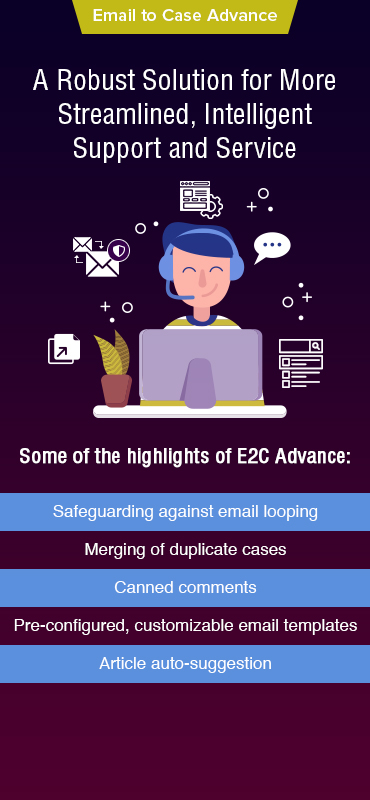“Happy customers are your biggest advocates and can become your most successful sales team.” – Lisa Masiello
Did you know that 93% of customers are more likely to repeat purchases with organizations that deliver a great customer experience?[1]
And Salesforce helps you to deliver exceptional customer experiences with its Service Cloud.
It enables your agents to have access to customer information and be a pro at delivering quality customer resolutions with case management.
Your customer support reps can handle customer cases (tickets) and provide quick and effective resolutions.
But a few snags that may come in the way of this are:
- Mismanagement of cases causing unprecedented service downtime.
- Needless escalations causing increased support costs and reduced ROI & profitability.
With Email-to-Case in Salesforce, you can manage your cases effectively. It helps you generate a case when a customer logs their query as an email.
However, with the standard Email-to-Case functionality in Salesforce, there are a few areas that can be enhanced to not only meet your customer’s demands but also exceed their expectations.
Read this blog post to learn how you can deliver the best customer experience by enhancing the capabilities of the standard Email-to-Case functionality in Salesforce.

Key Areas that Can be Enhanced in the Email-to-Case Functionality
Email-to-Case (E2C) is among the most widely used features in Salesforce Service Cloud. However, there are hindrances that come in the way of superior customer service. They are:
- Creation of duplicate cases from an email thread
- Limited templates to choose from
- The inability to reopen closed cases automatically
- The lack of notifications when a customer has created a new issue in a closed case
- Forwarding of emails in cases that are difficult to understand
All this can stop you from reaping the most out of your Salesforce Service Cloud investment.
Taking the Standard Email-to-Case Functionality to the Next Level
Better case management would not only reduce the burden on your support representatives but will also help them provide better case resolutions to your customers.
Let’s take a look at how you can enhance the capabilities of Email-to-Case in Salesforce Service Cloud.
- Improving the Way You Manage Duplicate Cases
One of the biggest factors that deteriorate the productivity of your support agents is the duplicity of cases. Since your customers can reach out to you through several channels such as online communities, social media, chatbots, websites, etc, the possibility of duplicate cases is not a surprise. Eliminating duplicate cases can help you streamline the workflows of your support agents and enhance their productivity.
- Sending Help With Confirmation Emails
Making your customers wait for resolutions is never good. By sending in help to your customers at the earliest, you can improve the deflection rate. As soon as a case is logged into Salesforce, you need to analyze the customer emails, identify the keywords, and search the associated knowledge base to find the relevant articles. As a good practice, you should share the articles with a confirmation email so that your customers can get immediate resolutions.
- Adding a Canned Comments Functionality
Commenting on commonly asked questions only adds to the job of your support agents. By having a ‘Canned Comments’ functionality, you can save your support representatives a lot of hassle. It can help you save their time and effort by using the comments to answer the most commonly asked questions.
- Handling Non-Customer Emails
Receiving non-customer emails is quite common, however, when support agents need to pay attention to them, their productivity takes a major hit. Therefore, it is imperative to manage non-customer emails effectively to reduce the burden on your support representatives.
- Managing Closed Cases
Just like duplicate cases and non-customer emails, closed cases can reduce the productivity of your support agents by asking for attention which can be better provided on some other task. To enhance your case management efforts and reduce the burden of cases that do not require your support rep’s attention, you need to have a solution that helps you manage closed cases effectively.
A Brief Round-Off
By simplifying cases for your support reps, you can deliver a great quality experience.
And this is where you need a solution that boosts the capabilities of the standard Email-to-Case functionality in Salesforce.
At Grazitti, our Salesforce-certified jedis have built a Salesforce-native and Lightning-ready solution, Email-to-Case Advance that helps you take the standard E2C functionality in Salesforce to a new level.
Email-to-Case Advance enables you to:
- Send Suggested Articles Along With the Confirmation Emails
- Easily Track Case History
- Keep Case Comments Clean
Want to Enhance the Capabilities of E2C with Email-to-Case Advance? Let’s Have a Word!
check it out on Salesforce AppExchange.
Should you want to know more, please drop us a line at [email protected] and we will take it from there.
Statistics References:
[1]- 107 Customer Service Statistics and Facts You Shouldn’t Ignore











